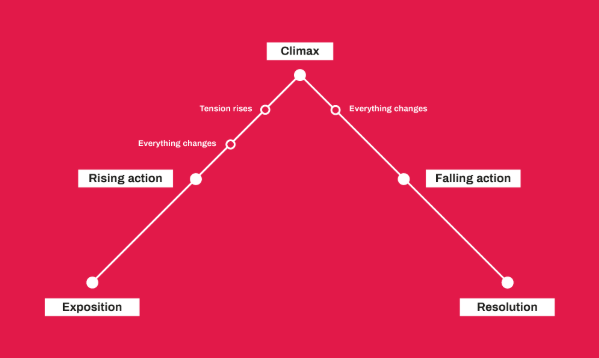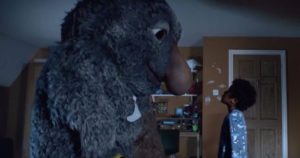Storytelling is an important part of compelling brand content. Sometimes, you’ll have things to say that don’t fit on your social channels or company website. You might have an exciting new partnership you want to tell everyone about, a new product launch or a social cause you’re supporting. Storytelling content can raise greater awareness and engagement for your new offering than social and site updates.
Traditional advertising and ‘push content’ aren’t as effective as they once were. They’re both ways of communicating messages that you regularly push out to your existing audience who’re usually already familiar with your offering. Customers today expect a more emotional connection with brands.
The value of storytelling is that it allows you to create a stronger connection with existing and new audiences.
Narrative arc
All good stories are made up of the same components. Joseph Campbell identified the typical structure of fictional narratives in his book The Hero with a Thousand Faces. His theory about the components that make up all the ancient mythological stories have been widely applied to modern storytelling.
The components can be called different things, and sometimes you don’t need to spend equal time on each or they don’t appear in this order. But they’re present in all good stories in some way because they’re a great way to make sure you’ll keep the audience engaged for the duration.
Exposition: This is the background and scene setting. For example, information about the setting, characters’ backstories, prior plot events, historical context, etc. This part is important because it gives the audience reasons to care what happens next.
Rising action: There is a quest to go on or a problem to overcome. The characters start to problem solve and you know something is going to happen.
Climax: This is the pinnacle of the story: where the tension and drama happens.
Falling action: Here the action starts to end and the loose ends get tied up.
Resolution: A good resolution neatly resolves the problems and offers some reflection. The audience should feel satisfied or moved to action.

Creating a story
When creating branded stories, you should consider what you have the right to say. Stories need to be relevant to your product, service or brand in order to be authentic. Think about a theme, value or idea you want to champion or question.
When you have a theme, you can decide how you want your audience to feel when they’re engaging with your story. Do you want them to be convinced of an idea? Do you want them to donate to charity? Buy a product?
The quest
First, think about the quest or mission that’ll be the base for your story. What’s the aim or goal for the hero? Take the audience on a journey that frames the mission, solves the problem and offers a conclusion. You need to know what your quest is so you can develop a narrative arc and messaging.
The characters
Who will be the story’s hero and what’s the brand’s role? It’s important for the audience to empathise with the hero. Could you partner with interesting people, influencers or other brands? People who have a right to tell the story or who embody the idea you want to get across?
The format
Once you have an idea about your quest, characters and messaging, you can think about what the best way to communicate this to the audience. The format should always be the last thing you decide. The core story should come first.
Great examples
Nike
 Nike: Nothing beats a Londoner
Nike: Nothing beats a Londoner
Sports brands are great at telling stories without using their brand as the hero. The Nike films Nothing beats a Londoner and This is greatness tell a story of overcoming obstacles featuring lots of different people as the heroes. These examples play with the storytelling structure by focusing on the rising action as a starting point without giving any time to set the scene. This means we’re immediately drawn into story and work out a backstory ourselves.
By featuring many different heroes rather than focusing on just one, Nike is giving the audience options to empathise with. They all face some kind of adversity that could stop them fulfilling their athletic dreams. Through their own determination and drive, they overcome the problem to be great at their chosen sport, which leads us through a change and resolution.
John Lewis

Elton John with his first piano
Every Christmas, the John Lewis adverts use powerful storytelling. They always feature the brand as the solution for the hero within the narrative arc. For example, the 2018 narrative is about how a gift can influence the course of someone’s life using Elton John as an example. If he hadn’t been given a piano as a gift, he wouldn’t have become one of the UK’s biggest music stars.
In this example, the narrative happens in reverse. We see the conclusion component first: Elton as his current self; then cut back in history to see the story that got him there.
In 2017, the Moz the Monster story accurately follows the structure above.

The 2017 John Lewis Christmas advert
Exposition: A child can’t sleep at night because there’s a noisy monster under his bed called Moz.
Rising action: He tries different things to stop Moz annoying him like wearing ear muffs.
Everything changes: He finally engages with Moz and they become best friends.
Tension rises: They have lots of fun together every night but this means the child keeps falling asleep during the day which causes problems. Moz sees that his friend is exhausted and things can’t go on like this so he gets him a gift for Christmas…
Climax: The child opens the present on Christmas morning and it’s a night light.
Falling action: We see from the child’s Mum’s face that in fact it was her who got him the gift, not the monster.
Everything changes: We realise that Moz wasn’t real and the child was just afraid of the dark. That’s why he couldn’t sleep.
Conclusion: With the help of his nightlight, he sleeps soundly and Moz disappears.
Allegro

The Allegro advert
This advert for Allegro (like eBay) tells the story of a Polish grandad learning English so he can speak to his grandchild that he’s never met.
He’s the hero of the story and the goal is to overcome a language barrier. Like the John Lewis adverts, the brand has a supporting role by offering the solution to the hero’s problem.
This structure is interesting because the majority of the story is spent on the earlier components like exposition and rising action. So we see the hero’s journey (learning a new language) but we don’t know why he’s doing it yet.
The story builds and ends on the climax. We realise that the build up was so he could say “Hi, I am your grandpa” to his English-speaking grandchild the first time they meet.
Conclusion
Telling a compelling brand story doesn’t have to follow the chronology of a traditional narrative arc. You can use the components to emphasise the point you want to make. But the way you create an emotional connection is through your hero.
The power of storytelling is being able to create a feeling of empathy in your audience. You get the opportunity to persuade and make people act or think differently towards your brand.
Stories give brands a chance to show what they stand for in new and creative ways.
Further reading
When strategy meets empathy – the power of a good story
Struggling to tell your brand’s story? We offer a full range of creative solution that you can check here.
Find us on DesignRush
